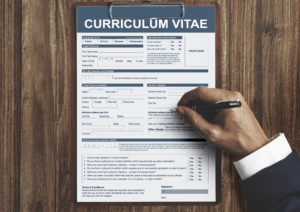On average, an employer spends 20 seconds looking at a CV before they make their decision and either put it aside to look at it again… or it is never seen again.
The employer has many CVs to examine before deciding who to call for an interview, especially in this economic climate, when so many are received. It is an onerous task and the entire CV for each candidate is rarely read. Each CV is merely skimmed.
So what do you do with your 20 seconds?
Your first page will determine if your CV will be read in full and increase your chance for an interview.
What to avoid:
- Spending the first 20 seconds stating your name, address and telephone number in overly big font taking up too much space on the page.
- Even if you have 10 years’ experience, start explaining where you went to school and what grades you got for woodwork.
- Start explaining what you did in your last position down to every detail only to find that you don’t manage to explain another previous role which was much more relevant.
- Tell the interviewer your life goals and explain what you would be looking for if they hired you.
- Listing all your hobbies and leisure activities.
- Creating a CV that is longer than a maximum of 2 pages
What to do:
- Target the position for which you are applying directly with your CV to ensure that you get the message across in 20 seconds that you are perfect for the role.
- You are selling and advertising your skills and ability to do the job, not writing an essay.
- Don’t bullet point our everything you have done. If you have achieved something in a particular position describe it in a full sentence and bullet out the rest.
Here’s what the interviewer wants to conclude after a 20 second interview:
This person has:
- The skills I require and the experience of using these skills.
- Understands my requirements.
- Provided benefits to previous clients/employers using those skills.
Let’s look at the technicalities

Formatting:
Be consistent about the type of formatting you use! Font’s, colours and size have to be chosen carefully and not overused. Ensure your CV is formatted the same throughout and that there are absolutely no spelling and grammar errors.
It is one of the worst mistakes to submit a CV that is not proofed in the area of spelling and formatting and state that you have great attention to detail.
Alignment and proper use of bullet points etc. is very important to make the CV look tidy and professional. Keep an eye on lower and upper case words and make sure all alignment in each section is same as in previous. Use Show/Hide function in Microsoft Word to look for any discrepancies.
Make sure you insert page numbering, even if it is just two pages it still looks professional. Bottom, middle of the page is your best choice.
Unless you are applying for a job in the creative/design market, do not overdo it. Fancy CV’s created in InDesign for example, with beautiful and eye-catching graphics might look tempting but they are not going to give you points when you are applying for a position in accounts or reception.
Keep in mind that when you are applying for office jobs that require you to be an efficient Microsoft user and your CV is badly created using Word, it is a very bad first impression you will make.
Length:
Your CV should be a maximum of 2 pages long, anything longer than that will just look bad. Remember, it is not your life story or an essay; you do not have to detail every single job you did. Extract what is most relevant and only mention the rest.
Headings:
Your experience and education are the most important sections of your CV. The type of job you are applying for and the type of experience you have will determine what will go first.
If you are applying for jobs you have previous working experience in then your first heading should showcase your ‘Employment History’. If you don’t have any relating experience but you are doing training to change careers then showcase ‘Education’ section on the first page.
Text Size:
Best size for:
Headings is 13-14
Subheadings is 11-12
Body is 10-11
Keep in mind that font size will also depend on the type of font you choose, some fonts look much smaller even though they are still the same size as any other.
Emphasis:
Do not emphasise too much. Embolden your headings but don’t underline them at the same time. You can add some colour to your headings, nothing bright though.
Cover Letter:
Always create a separate cover letter where you can address the company directly, describe why you are applying for the position and why you think you would be the best candidate. This should not be included on your CV on the top as it will take away space and attention away from what is really important.
References:
Always, where possible, include two references. Simply listing ‘references available on request’ is not what the employer wants to see. They want to know that there are people willing to recommend you and they will not call them straight away anyway, in most cases the potential employer will wait to call your contacts after the interview.
Leaving them out gives a bad impression and employers do not have the time to request your references, they want them available.
Contact details:
There is no need to prefix your email and phone with their descriptive words (e.g. Email: janedoe@anyemail.com). It is unnecessary clutter and we all know it is your email, the prospective employer will as well.
Don’t use a jokey email, such as sassyjane@email.com, this could be seen as immature or foolish. Also, consider what you publish online, employers do check social media, even for senior roles — so expect to be Googled…
What Format of CV should I use?
Starting the writing process can be tricky – how do you know what format would suit your career choice? What do recruiters find easy to read? Well, help is at hand — once you’ve identified which career description best fits your circumstances and experience from the options below, you should be able to apply the templates that are included at the end.
Graduate
Recently qualified and applying for a relevant position? You are going to showcase your qualification on the first page. Ensure you highlight any skills that are relevant as well, any way that will back up your ability to apply the theory in practice is what interests your potential employer.
Promotion
With plenty of background your CV should use reverse chronology template and show the most recent work history first. You should use this type of CV format especially if you are staying with the same employer or climbing the ladder within the same industry.
Changing Career
In today’s economic climate the ability to retrain and/or transfer to a new sector is often unavoidable. You want to master the flexibility necessary to make a 180 degree change in your career and your CV should show this. Let’s use an example of Mary who worked 15 years in the serving industry and after upgrading her office skills started applying for a secretarial role. Mary was worried that the course she completed wouldn’t be enough to get a job with no previous office experience. Her CV was designed to highlight all transferable skills and attributes she gained in her previous unrelated roles on top of her recently completed office course. Mary got the job even though she lacked experience! So what skills did she develop working in the serving industry that would make her a great secretary? She worked fast and developed great memory when taking orders. Her customer care skills were fantastic and the employer looked for someone with great communication skills.
If like Mary, you don’t have all the necessary experience, however, you have gained the skills through a course you also can get the job. Don’t be afraid to apply, even when the job specifies that a number of years of experience are required and you don’t have it. Employers are hoping for the best but often hire employees without experience who adequately prepared their CV and completed training to gain necessary skills.
Always adjust your CV for the job. If your CV is 10 years old don’t just add the missing 10 years, make sure you reorganise it to make it as much appealing as possible. If you have to remove a position that has nothing to offer for that particular job, do it, or input only the company name, your title and duration. This will give you space to expand on relevant education and positions.
Remember that a well organised and formatted CV is half of your success!

